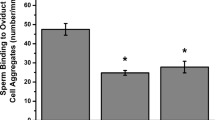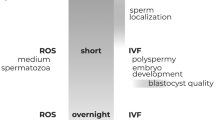Abstract
CAPACITATION of rabbit sperm in vitro has been reported1, but never when mixed with live heterologous granulocytes; neither has it been accomplished with incubation for only several hours. A hypothetical explanation as to the nature of capacitation, which enables sperm to penetrate and utimately fertilize ova, has been published elsewhere2. A recently perfected technique is available for indirect measurement of capacitation3. This fluorometric procedure requires the labelling of sperm with tetracycline HCl (T-HCl) (ref. 4), and its removal correlates with conditions in which sperm are known to capacitate. Repeated attempts to remove T-HCl from sperm in vitro failed5 until such sperm were mixed with mule leucocytes. Further experimentation revealed mule neutrophils which phagocytosed rabbit sperm whereas eosinophils removed T-HCl but left sperm intact and alive. Removal of T-HCl from sperm in vitro in itself does not prove that these sperm are capacitated. Proof lies in the ability of these sperm to fertilize rabbit ova. Rabbit sperm can be placed experimentally in the oviduct several hours after ovulation and, unless these sperm are capacitated, the ova fail to cleave3. The work described here provides experimental evidence of partial capacitation in vitro.
This is a preview of subscription content, access via your institution
Access options
Subscribe to this journal
Receive 51 print issues and online access
$199.00 per year
only $3.90 per issue
Buy this article
- Purchase on Springer Link
- Instant access to full article PDF
Prices may be subject to local taxes which are calculated during checkout
Similar content being viewed by others
References
Kirton, K. T., and Hafs, H. D., Science, 150, 618 (1965).
Austin, C. R., Intern. J. Fertil., 12, 25 (1967).
Ericsson, R. J., Proc. Soc. Exp. Biol. and Med., 125, 1115 (1967).
Ericsson, R. J., and Baker, V. F., Nature, 214, 403 (1967).
Ericsson, R. J., J. Reprod. Fertil., Suppl. No. 2, 65 (1967).
Archer, G. T., and Hirsch, J. G., J. Exp. Med., 118, 277 (1963).
Bjersing, L., and Borglin, N. E., Acta Path. Microbiol. Scand., 60, 27 (1964).
Rytömaa, T., Acta Path. Microbiol. Scand., Suppl. 140, 1 (1960).
Davis, M. E., and Hulit, B. E., J. Clin. Endocrinol., 9, 714 (1949).
Weil, A. J., J. Reprod. Fertil., Suppl. No. 2, 25 (1967).
Boettcher, B., J. Reprod. Fertil., 16, 49 (1968).
Roberts, A. N., Nature, 210, 266 (1966).
Litt, M., J. Cell. Biol., 23, 355 (1964).
Piko, L., Intern. J. Fertil., 12, 377 (1967).
Author information
Authors and Affiliations
Rights and permissions
About this article
Cite this article
ERICSSON, R. Capacitation in vitro of Rabbit Sperm with Mule Eosinophils. Nature 221, 568–569 (1969). https://doi.org/10.1038/221568a0
Received:
Issue Date:
DOI: https://doi.org/10.1038/221568a0
This article is cited by
-
Estrogen action in the male
Experientia (1979)
-
Uterine Changes during Capacitation in the Golden Hamster
Nature (1971)
-
Oestrogene im Leben der Frau
Archiv f�r Gyn�kologie (1971)
-
Versuche mit Rinder- und Schweinekeimzellen zur Reifung, Befruchtung und Embryonenz�chtung in vitro
Archiv f�r Gyn�kologie (1970)
Comments
By submitting a comment you agree to abide by our Terms and Community Guidelines. If you find something abusive or that does not comply with our terms or guidelines please flag it as inappropriate.



